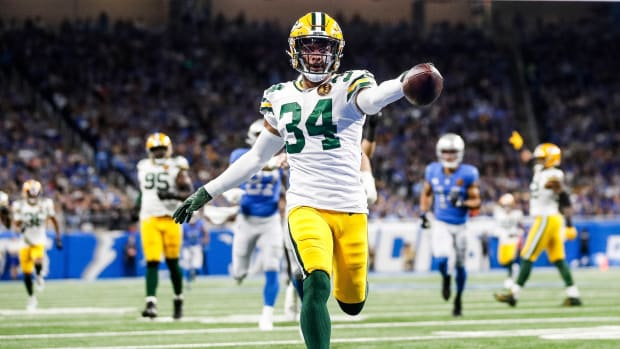Versatility Is Best Way to Handle ‘Worst-Case Scenario’ on Offensive Line
GREEN BAY, Wis. – There are 292,201,338 combinations in PowerBall. There’s not quite that many combinations on the Green Bay Packers’ offensive line, though it might seem that way.
Elgton Jenkins played center at Mississippi State, was a Pro Bowl guard in 2020 and thrived at left tackle in place of David Bakhtiari in 2021. Whenever Jenkins is fully recovered from his torn ACL, he might be the team’s starting right tackle.
Rookie third-round pick Sean Rhyan was a three-year starting left tackle at UCLA who might wind up at guard.
While at Wake Forest, rookie fourth-round pick Zach Tom started at center as a sophomore and at left tackle as a junior and senior. He hopes to be a five-position player as a rookie.
Last year’s starting guards, Jon Runyan and Royce Newman, played tackle in college.
Lucas Patrick and Billy Turner, who joined the Bears and Broncos, respectively, this offseason, were three-position starters during their time with the Packers.
Versatility was a calling card of Adam Stenavich’s offensive lines, and that will remain true with Stenavich promoted to offensive coordinator and Luke Butkus stepping in as offensive line coach.
To Stenavich, getting the best five linemen on the field, even if that means some musical chairs, is a better approach than playing his No. 8 lineman just because he’s the backup at a specific position.
“It just comes from worst-case scenario, kind of planning for the worst,” Stenavich said on Tuesday, a week ahead of the start of organized team activities. “It’s just basically trying to be prepared for things that can happen.”
Depth is like a fire extinguisher – break the glass when needed. It was especially needed last year, with Bakhtiari playing only one game, Jenkins missing nine games and Turner missing four games.
“In 2019, we really didn't have to dig into our depth that much,” Stenavich continued. “We had pretty much a starting five that played the entire season. And then 2020 and 2021 was a little bit different story. So, it’s just making sure you’re getting the guys ready for the worst. And once you get the right kind of guys in the room, every single guy prepares to be a starter. And then once their number’s called, it’s not that big of a transition.”
For the most part, Stenavich made the right calls when running the offensive line. He was right on moving Jenkins to left tackle. He was right on inserting Yosh Nijman at left tackle when Jenkins went down. However, with Bakhtiari inactive for the playoff loss against San Francisco, Stenavich perhaps was wrong in moving Turner from right tackle to left tackle and going with veteran Dennis Kelly at right tackle when he could have gone with Nijman at left tackle and kept Turner at right tackle.
“It’s really important to the standard that we have, to make sure we can uphold that standard, and every guy on this team knows that,” Stenavich said.
The standard will be the same in 2022, even if the roster is not. Turner, Patrick and Kelly are gone, Bakhtiari presumably will be back after playing just 27 snaps last year, and Rhyan, Tom and Rasheed Walker were added in the draft.
When the offseason practices start next week and training camp convenes sometime around Aug. 1, the Packers might line up with Bakhtiari at left tackle, Runyan at left guard, Josh Myers at center, Newman at right guard and Nijman at right tackle.
Where will Jenkins line up when he’s healthy? And which of the rookies will emerge to provide the next man up who was so important last year?
The first preliminary steps in making those decisions will happen during the shorts-and-helmets practices of OTAs.
“You can tell if they can handle the assignments, they’re on top of who they need to block and what their pass protection assignments are and just the overall scheme,” Stenavich said of what will be learned during four weeks on the practice field. “But then, once you get the pads on, that’s when you can really see if they’re physically ready to play. You’ve got to assess the mental side, and you can assess the physical side once you get rolling into real football.”





